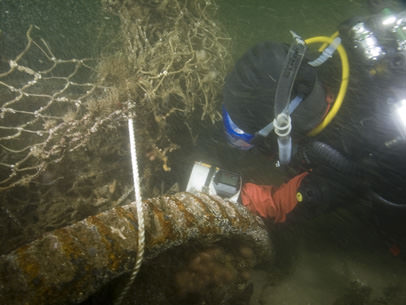Marine Debris
Monitor

Why is it a concern?
Marine debris is defined as any persistent, manufactured, or processed solid material that is directly or indirectly, intentionally or unintentionally, disposed of or abandoned into the marine environment. Marine debris includes a wide variety of objects (for example derelict fishing gear, lost vessel cargo, plastics, etc.) that pose a threat to the marine environment, human health, and/or navigation. Various types of debris, including fishing gear, plastic bags, foamed polystyrene, balloons, and other consumer goods, are known to have adverse effects on marine species.
Levels of debris in both the ocean and at the land-sea interface are of growing concern. Within the past few years, one of the biggest concerns at the Monitor sanctuary has been marine debris, particularly the possibility of commercial fishing gear striking the wreck. There have been observations of commercial fishing gear, monofilament, trawling nets and long lines tangled on the site. Other concerns include the dumping of soda cans, beer cans and leftover food in the sanctuary, usually the result of charter fishing vessels visiting the site. Additionally, marine debris could be recovered and mistakenly treated as part of the Monitor’s artifacts.
Overview of Research
The Flower Garden Banks National Marine Sanctuary is actively seeking research partners to conduct work connected to Marine Debris as a sentinel issue.
Science Needs and Questions
The best available science is used by Sanctuary scientists and managers working to address priority resource conservation and management issues. As priorities change and new issues emerge, each Sanctuary develops new science needs and questions and works with partners to address them.
- What is the source of the marine debris?
- What types of marine debris are found within and around the Sanctuary?
- What are the impacts of marine debris removal (biological and cultural)?
- What are the impacts of disregarding marine debris (biological and cultural)?
- Are there certain areas more susceptible to accumulation of marine debris?
Education and Outreach Material
NOAA Marine Debris Program Education Materials
Monitor National Marine Sanctuary Teacher Resources
References
Cuffey, R., Fonda, S., Bryozoans encrusting the 1862 Monitor Shipwreck off Cape Hatteras, Cheesebox, 1982, Vol.1, Number 1.
Dixon, R., Biology of the USS Monitor, NOAA Center for Coastal Fisheries and Habitat Research, Beaufort, NC, 1990.
Gittings, S.R., M. Tartt, and K. Broughton. 2013. National Marine Sanctuary System Condition Report 2013. U.S. Department of Commerce, National Oceanic and Atmospheric Administration, Office of National Marine Sanctuaries, Silver Spring, MD. 33 pp.
NMSP (National Marine Sanctuary Program). 2008. Monitor National Marine Sanctuary Condition Report 2008. U.S. Department of Commerce, National Oceanic and Atmospheric Administration, Office of National Marine Sanctuaries, Silver Spring, MD. 33 pp.
NOAA (National Oceanic and Atmospheric Administration). 2008. Marine Debris Emergency Response Planning in the North-Central Gulf of Mexico Interim Draft Report. 44pp.

